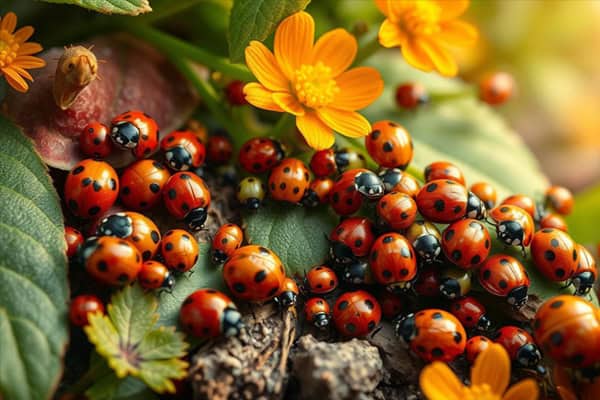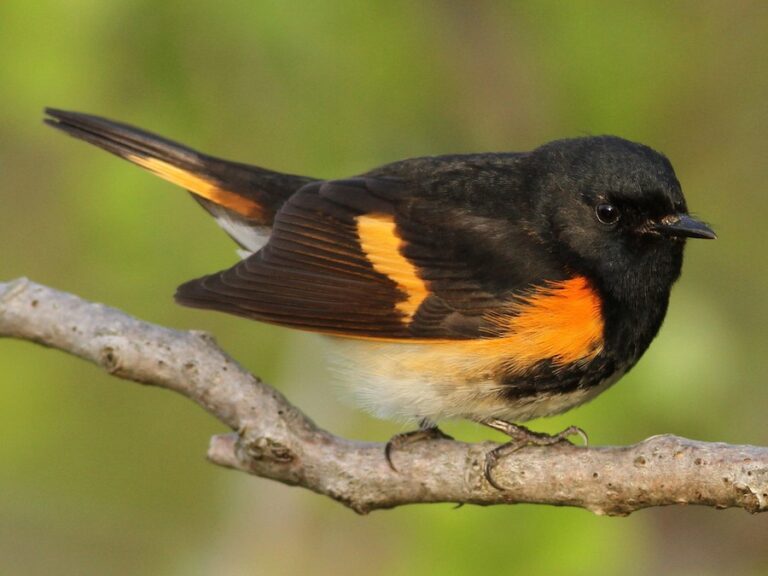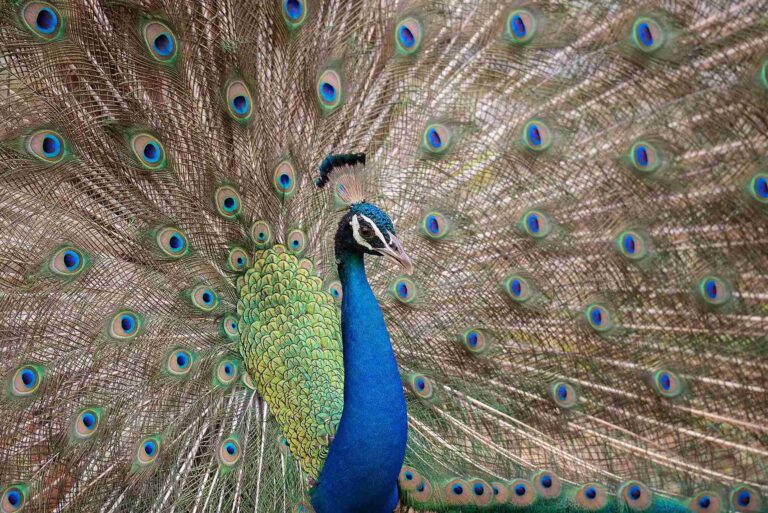Ladybugs Facts, Size, Lifespan, Habitat, Diet, Pictures
Did you know a single ladybugs can eat up to 5,000 aphids in its life? This shows how important they are in controlling pests. They are vital for gardeners and farmers. In this article, you’ll learn about their size, lifespan, where they live, and what they eat.
Ladybugs belong to the family Coccinellidae. They are known for their bright colors and helpful nature. They are about 0.3 to 0.4 inches big, which is quite fascinating. Let’s explore the world of ladybugs together. We’ll look into their homes, what they eat, and what makes them special.
Introduction to Ladybugs
Ladybugs are known for their bright colors and patterns. They are important for the health of many ecosystems. But what exactly are ladybugs? These small beetles are part of the Coccinellidae family. They are famous for helping control pest populations.
What Are Ladybugs?
Ladybugs, also called ladybird beetles, are round or oval in shape. They come in many colors, but red and orange are the most common. People like them because they eat aphids and other pests. This makes them helpful to farmers and gardeners.
Common Names and Scientific Classification
There are many species of ladybugs. The seven-spotted and two-spotted ladybugs are two well-known types. The name “ladybug” comes from the Virgin Mary, linking it to farming and good luck. Learning about different ladybug names helps us appreciate these insects more.
Size of Ladybugs
Ladybugs come in many sizes, which shows their amazing diversity. Most are about 0.3 to 0.4 inches big. With over 5,000 types worldwide, their sizes vary widely, which shows how they adapt to their homes and lives.

Average Size Range
Ladybugs usually measure from 0.3 to 0.4 inches. But some are bigger or smaller. For example, the large leaf-eating ladybug can be 0.27 to 0.35 inches long. This makes them really interesting to learn about.
Diversity in Size by Species
Each ladybug type is different in size, shape, and color. They adapt to various places and climates. For instance, the Asian lady beetle is about 0.4 inches long, but others can be smaller or bigger.
Here’s a table with some common ladybug species and their sizes:
| Ladybug Species | Average Size (inches) |
|---|---|
| Seven-Spotted Ladybug | 0.3 – 0.4 |
| Asian Lady Beetle | 0.4 |
| Large Leaf-Eating Ladybug | 0.27 – 0.35 |
| Two-Striped Ladybug | 0.3 |
This table shows how different ladybugs can be in size. It gives us a peek into their world. Ladybugs truly show the beauty of nature.
Lifespan of Ladybugs
These species are fascinating insects, and their lifespans are a topic of interest. In the wild, they usually live for 2 to 3 years. Their life cycle includes stages from eggs to adulthood, making them a key part of the ecosystem.
Average Lifespan in the Wild
In the wild, ladybugs live about 2 to 3 years. Warmer climates can help them live longer. They start as eggs and go through a big change to become the adults you see in gardens. Their survival depends on many environmental factors.
Factors Affecting Lifespan
Many things can change how long a ladybug lives. Important factors include:
- Climate Conditions: Bad weather can shorten their lives, forcing them to hibernate or reducing food.
- Food Sources: Eating lots of aphids and other pests is key for their survival and growth.
- Predation: Being eaten by birds and other insects lowers their chances of living a full life.
| Factor | Impact on Lifespan |
|---|---|
| Climate Conditions | Bad weather can shorten their lives, leading to hibernation. |
| Food Availability | Having enough to eat supports their growth and health. |
| Predation | More threats from predators means more ladybugs die early. |
Habitat of Ladybugs
Ladybugs live in many places, showing their ability to adapt. They can be found in everything from grasslands and forests to city gardens and riverbanks. This makes them interesting to learn about.
Preferred Environments
This species likes places full of aphids and other pests to eat. You can find them in:
- Grasslands: These areas have lots of plants and food.
- Forests: The thick trees and leaves protect and feed them.
- Urban settings: Gardens and parks have plenty of food for them.
- Riverbanks: These places are moist and have aphids, which ladybugs like.
In the cold, ladybugs find places to sleep together. They often enter homes, under rocks, or buildings to stay warm and safe.

Global Distribution of Ladybug Species
Ladybugs live all over the world. In North America, the seven-spotted ladybug is common for eating aphids. Ladybugs help ecosystems by living in many places.
Ladybugs are important in their ecosystems. They move between different places and help control pests in nature and cities.
Diet of Ladybugs
These species are important in nature because of what they eat. They mainly eat a variety of foods, making them great for gardens. Their diet helps them survive and also controls pests.
Main Food Sources
They love to eat soft-bodied insects. Their main foods are:
- Aphids
- Whiteflies
- Mites
A single ladybug can eat up to 5,000 aphids in its life. This shows how they can help control pests naturally, without chemicals.
Role in Pest Control
This species plays a big part in controlling pests. They eat pests like aphids, helping farmers and gardeners keep plants healthy. They act as natural pest controllers, supporting sustainable farming.
Ladybugs’ Unique Features
Ladybugs stand out with their distinctive characteristics. Their color is key to their survival. They often have bright colors like red and orange with black spots, which warn predators that they taste bad.
Coloration and Markings
The bright colors of ladybugs have many uses. They warn predators they are not tasty. This is called aposematism. The patterns and colors help them survive and can identify the species.
Defense Mechanisms
This species has strong defense mechanisms to keep it safe. It can release a bad-tasting fluid from its legs, and playing dead is another way it avoids danger. These actions show how it’s adapted to survive.
| Ladybug Feature | Description | Purpose |
|---|---|---|
| Coloration | Vibrant reds and oranges with black spots | Warning to predators of unpalatable taste |
| Secretion | Foul-tasting fluid | Deterrent for would-be attackers |
| Playing Dead | Inactivity in response to threats | Confuses or deters predators |
Life Cycle of Ladybugs
A ladybug’s life is an exciting journey with four main stages: egg, larva, pupa, and adult. These stages show how they grow quickly and play a key role in nature.
Stages of Development
It begins when ladybug females lay 5 to 30 eggs under leaves, close to the aphids they eat. After hatching, the larvae start eating aphids and other small bugs to grow. This stage lasts for weeks, with the larvae shedding their skin several times.
Then, this species goes through the pupal stage. Here, they form a pupa and change into adults. About a week later, adult ladybugs come out, ready to start the next generation. They reproduce in spring and summer.
Reproductive Behaviors
These species prepare for the next generation with unique ways of reproducing. Females can store sperm for later use. This means they can fertilize their eggs even when few males are around. This shows how ladybugs can keep going even in tough times.
| Stage | Duration | Key Characteristics |
|---|---|---|
| Egg | 3-10 days | Tiny, yellow to orange, often laid in clusters |
| Larva | 3-6 weeks | Active, elongated body, spiny appearance, voracious feeder |
| Pupa | 5-10 days | Transitional stage, immobile, undergoing metamorphosis |
| Adult | Up to 1 year | Colorful, capable of flight, ready for mating |
Fascinating Facts About Ladybugs
Ladybugs are more than just cute insects. They have deep cultural meanings and scientific interests. Their bright colors and friendly look make them perfect for studies and stories worldwide.
Cultural Significance
In many cultures, ladybugs are seen as symbols of luck and safety, and finding one is thought to bring good luck. This idea is part of many traditions and ceremonies, where these species are seen as signs of wealth.
Their stories and myths show how important ladybugs are in culture. This importance has lasted through the years.
Ladybugs in Space
NASA has sent ladybugs to space to study how they interact with other creatures in zero gravity. This is just one of the many interesting facts about ladybugs. They are important for science because they help us learn about life in space.
| Fact | Description |
|---|---|
| Symbol of Good Luck | Ladybugs are believed to bring fortune and are often associated with protection in various cultures. |
| Space Missions | NASA’s studies of ladybugs in space investigate their ecological interactions in microgravity. |
| Research Contributions | Ladybugs help scientists understand predator-prey dynamics and various ecological concepts. |
Read More🐦Related Articles:
| Spiritual Meaning of a Bird Building a Nest |
| Baby Birds Spiritual Meaning |
| Eagle Eggs: Fascinating Facts About Raptor Nests |
| Small Brown Birds In Florida |
| What Do Ducks Eat |
Conclusion
Ladybugs are more than just cute garden visitors. They are key to controlling pests and keeping nature in balance. By learning about their habits and life, we see how they help our planet.
These insects live in many places and adapt in unique ways. They are essential to the ecosystem. This shows how important they are and why we should protect them.
When you see a ladybug, remember the good they do. You welcome helpful friends into your world by creating a safe space for them.







